
An article published in Nature today highlights a scientific breakthrough – the isolation of a gene that enhances root growth thereby enabling rice to take up significantly more phosphorus, a critical nutrient for plant growth. That way, plants can obtain a large portion of their phosphorus requirement directly from the soil – a great boon for farmers who have to grow rice on problem soils with low phosphorus availability and cannot afford sufficient fertiliser.
Media Release – 23 August 2012
Rooting and shooting for rice: getting to the root of the matter to increase production
 An article published in Nature today highlights a scientific breakthrough – the isolation of a gene that enhances root growth thereby enabling rice to take up significantly more phosphorus, a critical nutrient for plant growth. That way, plants can obtain a large portion of their phosphorus requirement directly from the soil – a great boon for farmers who have to grow rice on problem soils with low phosphorus availability and cannot afford sufficient fertiliser.
An article published in Nature today highlights a scientific breakthrough – the isolation of a gene that enhances root growth thereby enabling rice to take up significantly more phosphorus, a critical nutrient for plant growth. That way, plants can obtain a large portion of their phosphorus requirement directly from the soil – a great boon for farmers who have to grow rice on problem soils with low phosphorus availability and cannot afford sufficient fertiliser.
Scientists have now isolated the gene that increases the uptake of phosphorus in rice, thereby increasing production. Dubbed PSTOL1, this gene makes the plant to grow more roots faster, thereby enabling it to absorb more phosphorus.
Globally, more than half of all cropland is low in plant-available phosphorus, posing a serious problem for poor, remote, rice-farming communities that must manage without fertilisers. Many such communities depend on upland rice. And while upland soils may have phosphorus, the problem is that this critical nutrient is locked in forms that are not readily available to rice plants, especially in acid soils.
Truly friendly fire: A ‘pistol shot’ from PSTOL1 goes a long way...
 “In field tests in Japan, Indonesia and the Philippines, rice with the PSTOL1 gene produced about 20 percent more grain on average than rice without the gene,” reveals Dr Sigrid Heuer, the project’s Principal Investigator, and a molecular biologist at the International Rice Research Institute (IRRI).
“In field tests in Japan, Indonesia and the Philippines, rice with the PSTOL1 gene produced about 20 percent more grain on average than rice without the gene,” reveals Dr Sigrid Heuer, the project’s Principal Investigator, and a molecular biologist at the International Rice Research Institute (IRRI).
The IRRI-led project that isolated the gene is part of the research portfolio of the CGIAR Generation Challenge Programme (GCP) and is an inter-institutional collaboration whose key partners are IRRI, the Japan International Research Center for Agricultural Sciences (JIRCAS) and the Indonesian Center for Agricultural Biotechnology and Genetic Resources Research and Development (ICABIOGRAD). GCP’s mission is to use genetic diversity and advanced plant science to improve crops by adding value to breeding for drought-prone and harsh environments. This is achieved through the generosity of several funders and a network of more than 200 partners drawn from CGIAR Centres and Programmes, academia, regional and national research programmes, and capacity enhancement to assist developing-world researchers to access technologies and to tap into a broader and richer pool of plant genetic diversity. GCP is funded multilaterally.
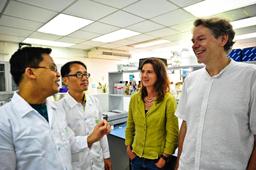 Gambling sometimes pays
Gambling sometimes pays
“We have now hit the jackpot and found PSTOL1 – the major gene responsible for improved phosphorus uptake – and understand how it works,” says Dr Heuer. PSTOL stands for stands for phosphorus starvation tolerance, and is one of 68 initially predicted putative genes in the locus that project scientists had tagged as Pup1 – short for ‘phosphorus uptake 1’.
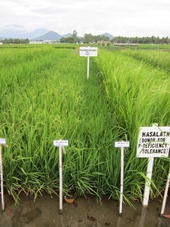 But it has been an epic journey and a long hard road getting there. The odyssey began in 1999, when Dr Matthias Wissuwa (who is now a researcher at JIRCAS) was a European Union fellow at Japan’s National Institute of Agrobiological Sciences (NIAS). The first breakthrough came about a decade ago, when Dr Wissuwa, then working in Japan, first discovered that an Indian rice variety, Kasalath, must have a gene that helps it thrive in low-phosphorus soils – a fact scientists already knew, even if they did not know the exact gene behind this. “What’s exciting about PSTOL1 is that it really does something positive in the field,” says Dr Wissuwa. “An early question we grappled with was whether better phosphorus uptake spurs root growth, or is it the other way round?” It’s a chicken-and-egg conundrum, but either way, a mechanism which favours phosphorus uptake results in improved root growth. A better root system is also beneficial under drought stress, which is GCP’s key focus.
But it has been an epic journey and a long hard road getting there. The odyssey began in 1999, when Dr Matthias Wissuwa (who is now a researcher at JIRCAS) was a European Union fellow at Japan’s National Institute of Agrobiological Sciences (NIAS). The first breakthrough came about a decade ago, when Dr Wissuwa, then working in Japan, first discovered that an Indian rice variety, Kasalath, must have a gene that helps it thrive in low-phosphorus soils – a fact scientists already knew, even if they did not know the exact gene behind this. “What’s exciting about PSTOL1 is that it really does something positive in the field,” says Dr Wissuwa. “An early question we grappled with was whether better phosphorus uptake spurs root growth, or is it the other way round?” It’s a chicken-and-egg conundrum, but either way, a mechanism which favours phosphorus uptake results in improved root growth. A better root system is also beneficial under drought stress, which is GCP’s key focus.
Impact…and the power of productive partnerships
The discovery of the PSTOL1 gene means that rice breeders will be able to breed new rice varieties faster and more easily using molecular markers, which ensure that selected plants will indeed have this valuable phosphorus-giving gene. This will go a long way towards meeting the project’s goal to contribute to improving rice in Asia, and going well beyond the immediate project partners.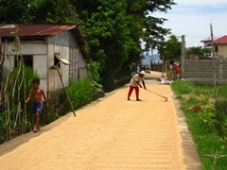
Farmers can expect to receive the first such rice varieties within a few years. Working with partners in Indonesia, the aim will be to breed varieties identical to those that farmers already know and trust, except that they will now have the PSTOL1 gene and an improved ability to take up soil phosphorus.
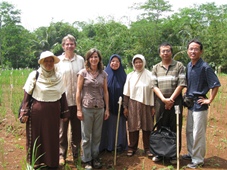 ICABIOGRAD is already breeding rice plants with the PSTOL1 gene. “The plants are not genetically modified: just bred using smart modern breeding techniques,” reveals Dr Joko Prasetiyono, an ICABIOGRAD molecular breeder. “In this case, we used marker-assisted selection, with close guidance from IRRI.” ICABIOGRAD partners with the Indonesian Centre for Rice Research (ICRR) to identify phosphorus-deficient hotspots for testing the breeding material, choose the best recipient rice varieties for the gene, and conduct the breeding.
ICABIOGRAD is already breeding rice plants with the PSTOL1 gene. “The plants are not genetically modified: just bred using smart modern breeding techniques,” reveals Dr Joko Prasetiyono, an ICABIOGRAD molecular breeder. “In this case, we used marker-assisted selection, with close guidance from IRRI.” ICABIOGRAD partners with the Indonesian Centre for Rice Research (ICRR) to identify phosphorus-deficient hotspots for testing the breeding material, choose the best recipient rice varieties for the gene, and conduct the breeding.
And impact is not limited to Indonesia: according to Dr Wricha Tyagi of the School of Crop Improvement at the Central Agricultural University in Meghalaya, India, knowledge of the exact gene will be critical for future breeding programmes suited to eastern and northeastern India where rice productivity is less than 40 percent of the national average due to acidic soils and poor availability of phosphorus. “We have screened Pup1-based markers on a set of about 75 rice genotypes and found Kasalath-like haplotypes in local and improved varieties adapted to these regions,” explains Dr Tyagi.
 "This research is a landmark achievement that includes both sophisticated basic research to understand the mechanism of phosphorus-uptake efficiency, as well as developing the improved varieties with better roots to absorb more phosphorous,” says Dr Rajeev Varshney, GCP’s Comparative and Applied Genomics Leader. “GCP is proud of this long-term investment in this exciting IRRI-led research which has borne fruit. Cloning the PSTOL1 gene has only been possible due to dedicated hard work by the project team, particularly, IRRI, JIRCAS and ICABIOGRAD."
"This research is a landmark achievement that includes both sophisticated basic research to understand the mechanism of phosphorus-uptake efficiency, as well as developing the improved varieties with better roots to absorb more phosphorous,” says Dr Rajeev Varshney, GCP’s Comparative and Applied Genomics Leader. “GCP is proud of this long-term investment in this exciting IRRI-led research which has borne fruit. Cloning the PSTOL1 gene has only been possible due to dedicated hard work by the project team, particularly, IRRI, JIRCAS and ICABIOGRAD."
Dr Jean-Marcel Ribaut, the GCP Director, notes, “This project exemplifies the ideal three-way partnerships GCP promotes, with the added benefit of a continuity of new and long-term collaborators. Here, we have a CGIAR Centre working with partners in both developing and developed countries, leading to a product that is of benefit to developing countries and meets a real need: this discovery will have significant impact on rice production, especially in rice-growing areas with acidic soils and poor availability of phosphorus.” 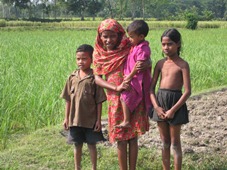
Besides the three main partners mentioned above (IRRI, JIRCAS and ICABIOGRAD working with ICRR) and NIAS, other partners that have been involved along the way, or provided information, include Italy’s University of Milano, Germany’s Max Planck Institute in Golm, the University of The Philippines at Los Baños, USA’s Cornell University and University of California (Davis and Riverside), Brazil’s EMBRAPA, Africa Rice Center, Iran’s Agricultural Biotechnology Research Institute, Australia’s Commonwealth Scientific and Industrial Research Organisation (CSIRO) and Dhaka University in Bangladesh.
The work done by the team is summarised in a Nature article published today entitled The protein kinase PSTOL1 from traditional rice confers tolerance of phosphorus deficiency.
"Publication in this high-impact journal validates the efficacy of GCP’s two-dimension research strategy coupling upstream high-quality science with applied aspects linked to breeding and, ultimately, farmers. I would once again like to applaud the team’s hard work and excellence," concludes Dr Varshney.
Links ![]() PDF version | Photo-story version in Flickr or Facebook | VIDEO: short clip on BBC World News | AUDIO: Podcast | Improving rice in Asia |
This email address is being protected from spambots. You need JavaScript enabled to view it.
| Funders | IRRI media release
PDF version | Photo-story version in Flickr or Facebook | VIDEO: short clip on BBC World News | AUDIO: Podcast | Improving rice in Asia |
This email address is being protected from spambots. You need JavaScript enabled to view it.
| Funders | IRRI media release
Related blogposts: S Heuer (IRRI) | J Prasetiyono (ICABIOGRAD) | M Wissuwa (JIRCAS)
